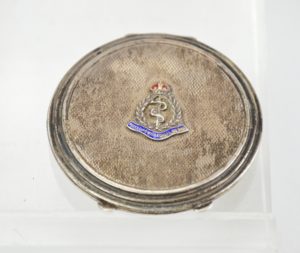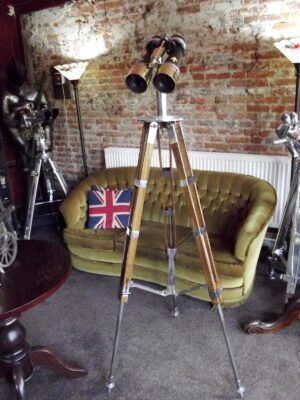*British, Post WW2, HMS Olympus – Original Photograph and Large Brass Model of Oberon Class Submarine*
A large brass unnamed model of a submarine – likely Oberon-Class. Accompanied by an original photograph of HMS Olympus dated 1970. This photograph originally formed part of the Lou Britton British Submarine Collection, which was acquired by the Royal Navy Submarine Museum, Gosport in 2007. HMS Olympus was an Oberon-class submarine that served with the Royal Navy before being transferred to the Canadian Forces as a training vessel.
Approximate measurements:
Model: 42.5cm x 5.3cm tall (from sub base), 4cm wide, (3.5cm length of central weight / mounting block)
Wire Photograph: 23.5cm x 19.5cm
Photograph marked on the front: “London 3/3/1970: Tall blocks of council flats make an unfamiliar “backcloth” for the Royal Navy submarine HMS Olympus as she berths in Surrey Docks, London, to-day. The Olympus is one of five submarines – four from the Royal Navy, the other from the Royal Australian Navy – which arrived in Surrey Docks to-day for a six-day visit to London. They will be open to the public tomorrow and Sunday. PAP 145060-1 (S-R)”. Marked on the reverse: Used 4 Apr 1970, Newspaper article “The subs come to town. Tall blocks of council flats make an unfamiliar background for the Royal Navy submarine HMS Olympus as she berths in Surrey Docks, London. The Olympus is one of five submarines-four British, the other from the Royal Australian Navy-which arrived at the docks for a six-day visit to London. They are open to the public today and tomorrow.”
Design and Construction
The Oberon class, an evolution of the Porpoise class, featured improved equipment, internal fittings, and higher-grade steel for the pressure hull, allowing for a diving depth of approximately 1,000 feet (300 m). The submarines were 295 feet (90 m) long overall, with a beam of 26.5 feet (8.1 m) and a draft of 18 feet (5.5 m). They displaced 1,610 tonnes surfaced and 2,410 tonnes submerged.
Powered by two Admiralty Standard Range diesel generators and electric motors, Olympus had a top speed of 17 knots submerged and 12 knots surfaced. Armament included eight 21-inch torpedo tubes (six forward, two aft) with 24 torpedoes. The crew consisted of 68 personnel.
Service History
Laid down by Vickers-Armstrongs on 4 March 1960 and launched on 14 June 1961, Olympus was commissioned into the Royal Navy on 7 July 1962. In September 1967, she participated in the search for a French Navy Breguet Atlantic aircraft. In 1969, a practice torpedo she fired malfunctioned, nearly hitting the MV Countess of Breadalbane.
During the Falklands War in 1982, Olympus was initially believed to have been deployed to the South Atlantic but instead participated in NATO exercises off Scotland. After a two-year refit completed in July 1982, which included upgrades for special forces operations, she joined the First Submarine Flotilla at Gosport.
In 1986, Olympus featured on the Channel 4 game show Treasure Hunt, where presenter Anneka Rice landed on her hull to receive a clue.
Canadian Service and Disposal
Decommissioned from the Royal Navy, Olympus was sold to the Canadian Forces in 1989 for use as a non-operational training vessel in Halifax, Nova Scotia. She was never commissioned into Canadian service and was listed for disposal in 2000.
Despite calls to preserve her as a museum ship in Barrow-in-Furness, her birthplace, Olympus was sold for scrap in 2005. In July 2011, she was moved to a scrapyard in Port Maitland, Ontario, where she was dismantled.
*Condition*
The model is in excellent condition with minor marks and scratches. Please see photographs as part of the condition report.
RQMGEOXABDO_5651193266






















